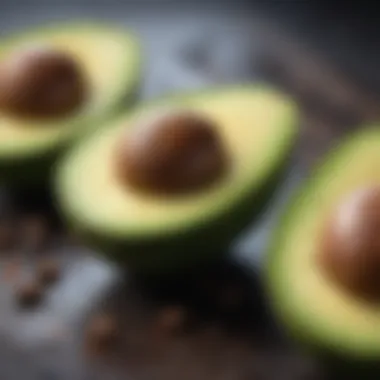Delicious Snacks for Keto Diet Enthusiasts


Intro
The ketogenic diet has gained significant attention in recent years. This low-carb, high-fat approach aims to shift the body into a state of ketosis. During ketosis, the body uses fat as its primary energy source. This results in weight loss and other health benefits. While the main focus of the keto diet lies in meal planning, snacks also play a crucial role.
Snacks can aid in maintaining energy levels and preventing cravings between meals. They can also provide an opportunity to meet macronutrient goals. In this article, we will explore various keto-friendly snack options and provide tips on preparation, storage, and incorporation into daily routines. Understanding the health benefits associated with keto snacks and avoiding common pitfalls will be essential for success.
Health Benefits
Physical Health Benefits
Adopting a ketogenic diet can lead to several physical health benefits. First and foremost, it may promote weight loss by utilizing fat for energy. When your body enters ketosis, it becomes efficient at burning stored fat. This process can help reduce body fat percentages and may lead to a healthier body composition.
Additionally, many studies suggest that a ketogenic diet can improve blood sugar levels. People with type 2 diabetes or those at risk may find that stable blood glucose is easier to maintain on this diet. Furthermore, keto snacks often contain healthy fats and protein, which can support overall nourishment.
Mental Health Benefits
The effects of a ketogenic diet extend beyond just physical health. Ketosis may positively impact mental clarity and cognitive function. Many individuals report feeling more alert and focused when following a keto regimen. The brain utilizes ketones, a byproduct of fat metabolism, as an efficient fuel source.
Moreover, some research points to potential benefits for mental disorders, like anxiety and depression. By stabilizing blood sugar and promoting consistent energy levels, keto snacks may help reduce mood swings.
"The key to sustaining ketogenic success lies in selecting snacks that align with dietary goals, avoiding unnecessary carbohydrates while still enjoying satisfying flavors."
Practical Tips
Healthy Eating Guidelines
When selecting snacks on a ketogenic diet, prioritize those that are high in healthy fats and low in carbohydrates. Here are some helpful guidelines:
- Nuts and Seeds: Almonds, walnuts, and chia seeds are great options.
- Dairy Products: Cheese and full-fat yogurt can be both nutritious and satisfying.
- Vegetables: Opt for low-carb options like spinach, cucumbers, or bell peppers. Pair them with high-fat dips like guacamole.
- Protein Snacks: Beef jerky or turkey slices can provide essential nutrients and satisfy hunger.
Effective Workout Routines
While the focus is often on diet, exercise should complement your ketogenic journey. Here are some exercise tips:
- Strength Training: Incorporate weights into your routine to build muscle mass.
- Cardio: Engage in low-impact cardio exercises, such as walking or cycling, to enhance fat burn.
- Recovery: Ensure adequate rest to allow your body to recover and adapt to exertion.
Incorporating these healthy eating guidelines and effective workout routines will promote a balanced ketogenic lifestyle. The careful selection of snacks, paired with physical activity, forms a strong foundation for achieving your health goals.
Understanding the Keto Diet
The significance of understanding the ketogenic diet extends beyond simple weight loss. This dietary approach emphasizes a profound transformation in how the body derives energy. In a standard diet, carbohydrates are the primary source of fuel. However, by drastically reducing carbohydrate intake and replacing it with fats, the body enters a state known as ketosis.
Ketosis is a metabolic state where fats become the major energy source. This process yields an array of benefits, including improved mental clarity, increased energy levels, and enhanced fat loss. Understanding these benefits is crucial for anyone looking to incorporate this diet effectively.
Adopting this diet requires a nuanced understanding of macronutrients. Each individual may experience different results depending on their unique physiological makeup, making it essential to consider personal health conditions and lifestyle choices. Additionally, the psychological aspects of making such drastic dietary changes cannot be ignored. Adhering to the principles of keto demands dedication and awareness.
The Science Behind Ketosis
When carbohydrate intake is severely limited, the liver converts fats into ketones, which then serve as an alternative energy source for the brain and body. This process is not instantaneous; it generally takes several days of low carbohydrate intake for the body to adapt to burning fat instead of sugar. During this time, individuals may experience flu-like symptoms, referred to as "keto flu," as the body transitions.
Research has demonstrated that ketosis can promote fat loss while preserving muscle mass. This is particularly valuable for those who engage in regular physical activity. Additionally, ketosis may provide therapeutic effects, as seen in studies related to epilepsy and certain metabolic conditions.
Macronutrient Breakdown
A ketogenic diet typically consists of a macronutrient ratio of approximately 70-75% fats, 20-25% protein, and only 5-10% carbohydrates. Maintaining these ratios is critical for entering and sustaining ketosis.


- Fats: Focus primarily on healthy fats such as avocados, olive oil, and coconut oil. This is essential because fats provide the energy needed for bodily functions and aid in nutrient absorption.
- Proteins: Choose high-quality sources, including meat, fish, and dairy. While protein intake is important, excessive consumption can lead to gluconeogenesis, where protein is converted to glucose, potentially disrupting ketosis.
- Carbohydrates: Aim for low carb vegetables, nuts, and seeds. It is essential to limit high-carb foods, which may include grains, sugars, and most fruits, in order to maintain the necessary low carbohydrate intake.
Common Myths and Misconceptions
Several myths surround the ketogenic diet, influencing perceptions and practices. One prevalent misconception is that ketosis is synonymous with starvation. This is incorrect; ketosis is a metabolic process that allows for energy from fat while still consuming adequate calories from fats and proteins.
Another myth is that all fats are detrimental to health. In contrast, healthy fats are pivotal for sustaining the keto diet and enhancing overall health. Misunderstandings can lead to poor food choices that undermine dietary goals.
Additionally, there is a belief that individuals on the ketogenic diet cannot consume any carbohydrates. While extreme reduction is essential initially, some amount of carbohydrates, particularly from non-starchy vegetables, should be included for nutritional balance. Understanding these myths is vital for making informed decisions about dietary choices.
The Role of Snacks in a Keto Diet
Snacking on a ketogenic diet is more than just a convenient way to quell hunger. It plays a crucial role in maintaining energy levels, enhancing satiety, and supporting overall adherence to the dietary guidelines of keto. In this section, we will explore the benefits and considerations of including snacks in a keto lifestyle.
One of the primary benefits of snacks on keto is the sustained energy that they can provide. When following a low-carb diet, the body shifts from using glucose as its main fuel source to utilizing fat. This metabolic transition can result in fluctuating energy levels, especially in the initial phases of the diet. Thoughtfully chosen snacks can help bridge the gap between meals, preventing fatigue and irritability.
Moreover, snacks can enhance feelings of satiety. The ketogenic diet is naturally higher in fats, which are essential for promoting a sense of fullness. Including snacks rich in healthy fats, such as nuts or cheese, can significantly curb cravings, making it easier to resist high-carb temptations.
It is also essential to recognize the timing and context of snacking. Mindful snacking means making choices that align with your health objectives rather than allowing impulsive decisions to dictate what you eat. This approach involves selecting snacks that are nutritionally dense while adhering to macro restrictions. It helps in sustaining not just physical energy but also in maintaining a focused mindset toward one's dietary goals.
"Snacks can make or break adherence to a keto diet. Choose wisely and snack mindfully."
This section sets the stage for a more detailed discussion on the specifics of keto-friendly snack options, when to enjoy them, and how to ensure that snacking complements your overall dietary goals.
Snacks for Energy and Satiety
In the context of keto, snacks must be thoughtfully structured to provide both energy and durability. This section discusses specific types of snacks that fulfill the dual need for energy and satiety. High-fat, low-carbohydrate options are pivotal here.
Common snacks like almonds, walnuts, or pecans serve as excellent energy sources due to their healthy fat content. They are not only rich in omega-3 and omega-6 fatty acids, which are beneficial for heart health, but they also provide a significant amount of protein, making them a satiating choice. Each portion needs to be managed properly, as caloric density can rack up quickly.
Cheese offers another satisfying option. Whether you prefer string cheese, cheese crisps, or aged cheddar, they provide calcium along with protein. Each of these choices can keep hunger at bay between meals. Furthermore, they are portable, making them an easy choice for on-the-go snacking.
When to Snack on Keto
Understanding when to snack is as crucial as what to snack on. It can determine how effective your keto approach will be. Timing can influence satiety and portion control. While it might be tempting to reach for snacks throughout the day, it is essential to establish a pattern that fits individual hunger cues and lifestyle.
A common recommendation is to consider snacking only when true hunger signals arise. This often means waiting between meals and assessing whether it's true hunger or just a habitual urge to eat. This practice can help develop a healthier relationship with food, making you more in tune with your body’s needs.
Additionally, being aware of your daily activity can help dictate when snacks may be most valuable. For instance, if you have an active workout planned, consuming a fatty snack about one hour prior could provide the energy needed to perform well. Conversely, if you have a sedentary task ahead, snacking might not be necessary.
By recognizing both the how and when of snacking on a keto diet, one can craft an approach that not only satisfies immediate cravings but also enhances long-term adherence to the dietary framework.
Types of Keto Snacks
Understanding the various types of keto snacks is essential for anyone engaging in a ketogenic lifestyle. These snacks not only satisfy cravings but also play a critical role in adhering to low-carb protocols. The importance of these snack types can be attributed to their ability to deliver nutrients while preventing hunger between meals. Furthermore, a wide variety of keto snacks can help quell the monotony that often accompanies strict dietary regimens.
Nuts and Seeds
Best Choices for Keto
When selecting nuts and seeds for a ketogenic diet, almonds, walnuts, and chia seeds stand out as excellent options. Their high-fat content coupled with low carbohydrates make them suitable for maintaining ketosis. Nuts provide healthy fats that can improve heart health due to their omega-3 content, while seeds are rich in fiber and protein. These characteristics make them not only beneficial for dietary goals but also popular among individuals following keto. One downside to consider is the potential for overconsumption, as the calorie density of nuts might lead to exceeding daily caloric needs.
Portion Control
Portion control is critical in managing keto snacks. Nuts and seeds, despite being healthy, contain high amounts of calories. This means that moderation is paramount. Measuring out servings can prevent accidentally consuming a larger amount than intended, which could disrupt the balance of a well-planned ketogenic meal. Employing portion control helps keep track of macronutrients, ensuring that one stays within the desired limits for the day. However, relying solely on pre-portioned snacks may limit spontaneity and enjoyment.
Cheese and Dairy


Types of Cheese to Use
Incorporating cheeses, like cheddar, mozzarella, and cream cheese, is a great way to add flavor and richness to snacks. These cheeses are low in carbohydrates while rich in fats, making them suitable for a keto diet. They also provide protein and calcium, promoting overall health. However, certain cheese types should be avoided due to higher carbohydrate content, like ricotta or cottage cheese, which may hinder keto efforts. Keeping a variety of cheeses on hand allows for diverse snack options and enhanced meal enjoyment.
Limitations and Best Practices
While cheese is keto-friendly, it is essential to recognize limitations. Overindulgence in cheese can lead to excessive calorie intake and digestive issues for some individuals. Maintaining a balance is key to reaping the benefits without overdoing it. Therefore, adopting best practices, like limiting cheese intake to specific servings and paying attention to overall fiber consumption, ensures that cheese contributes positively to one’s dietary goals.
Vegetable Chips and Dips
Low-Carb Vegetable Options
Low-carb vegetable snacks are an excellent complement to a keto diet, with options like kale chips, zucchini crisps, and radishes gaining popularity. These vegetables are naturally low in carbohydrates and can serve as a satisfying alternative to traditional snacks. Their crispy texture coupled with nutrient density means they can provide essential vitamins while respecting the keto framework. However, over-processed veggie chips often contain added sugars and preservatives, so it’s advisable to prepare them at home for better control.
Making Your Own Dips
Creating dips at home can elevate vegetable snacks. Guacamole and sour cream are two great choices, both being low-carb while adding flavor. Home-made dips allow for customization without unnecessary additives. This practice not only enriches the snacking experience but also ensures quality ingredients. One drawback could be the time it takes to prepare, but the benefits of fresh flavors usually outweigh that concern.
Meat-Based Snacks
Jerky and Biltong
Jerky and biltong are popular among those on keto for their high protein content and low carbohydrates. Beef jerky offers convenience and portability, ideal for on-the-go snacking. However, it is essential to check for sugar content in commercial options, as many brands add sugars for flavor. Biltong, traditionally made from air-dried meat, often has fewer preservatives and is less likely to contain sugars, providing a more natural choice. Both snacks can be excellent sources of nutrients but can be costly or tricky to make at home.
Recipes for Quick Meat Snacks
Simple recipes for quick meat snacks can enhance meal planning. Options such as spicy chicken wings or egg muffins with sausage can cater to various taste preferences and satisfy hunger. These snacks can be prepared in bulk and stored, providing quick access to keto-friendly nutrition. However, preparation time can be a concern, requiring some initial commitment.
Keto-Friendly Bars
Commercial Options
Keto-friendly bars are convenient for those leading busy lives. Brands like Quest and Atkins offer bars that provide adequate protein and low carbs. These bars are an easy snack option. Nevertheless, it is important to be wary of the ingredients list; some bars might contain additives that were not accounted for, impacting overall health.
Homemade Recipes
Creating homemade keto-friendly bars can ensure control over what goes into the snacks. Recipes utilizing almond flour, coconut oil, and erythritol allow individuals to customize flavors. While homemade bars can require more effort, they can also be more fulfilling and authentic. The drawback is that preparation might take time, deterring some from making their own during busy days.
Nut Butter
Types of Nut Butter
Nut butters like almond butter and peanut butter can be a delicious addition to the keto diet. They offer healthy fats and protein that can help maintain satiety. These nut butters can also be incorporated into various recipes. However, it is essential to choose options without added sugars, as even small amounts can disrupt ketosis.
Serving Suggestions
Utilizing nut butters creatively is key to preventing snack fatigue. They can be spread on celery sticks or incorporated into smoothies for a delicious nutrient boost. Serving suggestions can expand the menu, providing a satisfying way to enjoy nut butter. Despite their benefits, portion control is crucial due to their calorie density and potential for easy overindulgence.
Egg-Based Snacks
Hard-Boiled Eggs
Hard-boiled eggs are one of the simplest and most nutritious keto snacks available. They are high in protein and healthy fats, making them a perfect option for a post-workout recovery snack. The convenience factor of eggs, which can be prepared in batches and stored, allows for easy access to nutrition. One trade-off may be seasoning, as some find them bland without additional flavoring.
Deviled Eggs Variations


Deviled eggs offer a variety of ways to enjoy this protein-rich snack. By experimenting with different ingredients, like avocado, bacon or mustard, one can create flavorful variations while still adhering to keto guidelines. These variations keep snacking interest alive and provide significant nutritional value, but they do require some prep time, which might be seen as a drawback for a quick snack.
Preparing and Storing Keto Snacks
Preparing and storing keto snacks is a critical component of sustaining adherence to a ketogenic lifestyle. Precision in both preparation and storage can augment the enjoyment of snacks while ensuring they remain compliant with low-carb guidelines. This section will elucidate the importance of meal prep for successfully managing your dietary choices, along with effective storage techniques to prolong freshness and prevent waste.
Meal Prepping for Success
Meal prepping is an integral part of the keto diet. It encourages structured eating habits and minimizes the temptation to indulge in non-compliant foods. When snacks are prepared in advance, they become accessible and convenient, which is essential for busy lifestyles. The foundation of successful meal prepping involves selecting keto-friendly snacks that align with one’s macronutrient goals.
An effective strategy is to aim for a balance of flavors and textures while incorporating a variety of nutrients. For instance, combining different types of nuts and seeds can provide healthy fats and proteins, creating satisfying munchables. In addition, utilizing ingredients such as cheese or low-carb vegetables can diversify your options. Consider allocating a specific day of the week for meal prep. This routine can streamline your snack selection for the coming days.
Key Points for Meal Prepping:
- Choose a day to prepare snacks.
- Incorporate a mix of flavors and textures.
- Use portable containers for easy access.
- Experiment with new recipes to keep it interesting.
Proper Storage Techniques
Storing prepared keto snacks properly is just as essential as preparation itself. Proper storage prevents spoilage and maintains taste and texture. Understanding how to keep snacks fresh will maximize enjoyment and adherence to your diet.
Utilize airtight containers to safeguard snacks from air exposure, which can lead to rancidity or staleness. When refrigerating items like cheese or dips, ensure that they are sealed tightly to retain moisture and prevent absorption of other odors. For items that can be freezer-friendly, such as homemade keto bars, consider portioning them out, labeling them with dates, and storing them in freezer bags. This practice extends shelf life significantly.
Moreover, consider rotating foods based on their expiration dates. A first-in, first-out system can ensure that older items are consumed first, minimizing waste. When storing snacks in the pantry, opt for a cool, dark place away from direct light and heat sources.
Storage Techniques for Optimal Freshness:
- Use airtight containers for preservation.
- Store dips and cheeses in sealed packages.
- Label frozen items with the date.
- Follow a first-in, first-out principle.
"Effective meal prepping and proper storage techniques can vastly enhance your keto journey, fostering longer-term dietary adherence and satisfaction."
Common Pitfalls to Avoid
When following a ketogenic diet, it is essential to understand the common pitfalls that can derail progress. Identifying and addressing these issues allows individuals to maintain a consistent approach to their eating habits while enjoying snacks that align with their dietary goals. Ignoring these pitfalls could lead to unintended carbohydrate intake, feelings of deprivation, or even weight gain. Here are key areas to consider that will enhance your understanding of managing ketogenic snacking.
Overindulgence in Snacks
Overindulgence in snacks is a significant risk for those on a keto diet. Although many snacks are low in carbohydrates, it is easy to consume excessive portions. High-fat snacks, while nutritious, can be calorie-dense. Keeping track of portion sizes is crucial.
- Understanding Satiety: Keto snacks often provide quick energy but may not promote the sense of fullness that comes from whole meals. This disconnect can lead to more frequent snacking.
- Setting Limits: One effective strategy is to establish a clear limit on snack consumption for the day. Having pre-portioned snacks can help prevent overindulging.
- Regular Monitoring: Consider tracking meals and snacks using apps or food diaries. Being mindful of what you consume keeps you accountable and reduces the chance of excessive snacking.
Implementing these suggestions may contribute to achieving weight loss or health milestones while on the keto diet.
Hidden Carbs in Snacks
Hidden carbs can be subtle yet impactful on a ketogenic diet. Many processed snacks labeled as “keto-friendly” may still contain ingredients that increase total carbohydrate counts. It's important to scrutinize product labels carefully.
- Reading Nutrition Labels: Always check the nutrition facts and ingredient lists thoroughly. Terms like “sugar alcohols” or “natural flavors” can hide extra carbs.
- Opting for Whole Foods: Whenever possible, choose snacks made from whole ingredients. This helps to ensure nutritional quality and reduces the likelihood of consuming hidden sugars.
- Educating Yourself: Familiarize yourself with common foods that may seem keto-friendly but are higher in carbs than anticipated. This knowledge empowers informed decisions.
Closure
The conclusion serves as a pivotal part of the discussion surrounding snacks on a keto diet. It synthesizes the information provided throughout the article, reinforcing crucial concepts about maintaining a ketogenic lifestyle while enjoying snacks. A thorough understanding of the subject helps readers navigate the potential challenges they may encounter, ensuring snacks contribute positively to their diet rather than detract from it.
Sustaining a Balanced Keto Lifestyle
Sustaining a balanced ketogenic lifestyle requires mindful choices when it comes to snacking. It is essential to recognize that just because a snack is keto-friendly does not mean it can be consumed without limits. Practicing portion control is critical. For example, nuts, while nutritious and low in carbs, can quickly lead to calorie overload if not measured appropriately.
Understanding the correct balance of macronutrients is also vital. Snacks should complement meals, not replace them. They should provide energy without excessive carbs that could potentially disrupt ketosis.
It is also important to prioritize whole foods. The market offers various pre-packaged, keto-friendly snacks, but many contain additives or hidden carbs. Reading labels carefully is crucial for avoiding unexpected ingredients that do not align with dietary goals.
To ensure snacks remain satisfying and nourishing, consider versatile options. Hard-boiled eggs are an excellent choice, offering protein and healthy fats. Similarly, vegetable sticks paired with homemade guacamole can keep cravings at bay, delivering both nutrition and flavor without exceeding carb counts.
In summary, maintaining a balanced keto lifestyle is about making informed snack choices. Each selection should align with overall dietary goals and help sustain energy while being mindful of portions and ingredients.















